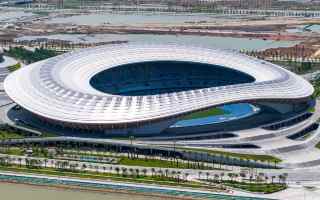Greater Bay Area Sports Center Stadium
| Capacity | 60 000 |
|---|---|
| Country | People's Republic of China |
| City | Guangzhou |
| Clubs | - |
| Inauguration | 23/08/2025 |
| Construction | 2023–2025 |
| Cost | CNY 8 B ($1.12 B) – entire complex |
| Design | Zaha Hadid Architects, GuangDong Architectural Design & Research Institute |
| Contractor | China State Construction Engineering Corporation |
Advertisement
Greater Bay Area Sports Center Stadium – stadium description
How does the Greater Bay Area Sports Center Stadium look in brief?
The 60,000‑seat Greater Bay Area Sports Center Stadium is the centerpiece of a large, flagship sports complex built with the 2025 Chinese National Games in mind. Due to a tight schedule, construction progressed at a record pace for facilities of this scale.
The complex was built in Nansha, a remote southern district of Guangzhou, located 80 km south of the city center. However, this location is far from random – it is referred to as the “geometric center” of the Guangzhou–Hong Kong–Macau megalopolis.
Although the area was previously underdeveloped, this is set to change. A branch of the 24‑kilometer bridge–tunnel crossing (Shenzhen–Zhongshan Link) has already been brought to the site, and plans include a metro station and further infrastructure investments.
The project was developed with the participation of the renowned British firm Zaha Hadid Architects, and its individual structures feature original architecture designed to symbolize pearls scattered along the shoreline.
The stadium itself stands out with an impressive arch, creating a large gap between the roof and the stands. This design allows the building to “open” to the east, offering spectators panoramic views of the Pearl River estuary.
The roof is styled after a traditional Chinese fan, while the facade draws inspiration from the appearance of ancient boats from the Song dynasty period. The stadium is multifunctional, equipped with an athletics track and two large video screens.
How did the Greater Bay Area Sports Center come about?
The decision to build the new sports complex was made after Guangdong Province, together with Hong Kong and Macau, was announced in August 2021 as the host of the 15th Chinese National Games, scheduled for November 2025.
Who designed the Greater Bay Area Sports Center?
The design for the Greater Bay Area Sports Center was selected through an international competition, with the results announced on July 21, 2023. The winning concept was developed by the renowned British firm Zaha Hadid Architects in collaboration with the Guangdong Architectural Design & Research Institute.
The Greater Bay Area Sports Center project can be viewed on a dedicated page
When was the Greater Bay Area Sports Center built?
The complex was constructed by two branches of China State Construction Engineering Corporation (CSCEC): the China Construction Third Engineering Bureau and the China Construction Eighth Engineering Bureau.
Construction proceeded at an extraordinary pace, setting speed records for sports facilities of this scale in China. Work began in August 2023, and the complex was completed by June 2025. The investment cost exceeded 8 billion yuan.
The project was initially referred to as the Nansha Cultural and Sports Complex, but it was eventually named the Greater Bay Area Sports Center.
A construction report of the Greater Bay Area Sports Center can be viewed on a dedicated page
When was the Greater Bay Area Sports Center Stadium inaugurated?
The first event in the new complex was a basketball tournament held in the sports hall on 10 August 2025. The main facility, the stadium, officially opened on 23 August 2025.
The stadium’s inauguration featured a match of the regional Guangdong Football Super League between the Nansha Bay Area Youth Team and the Wuchuan Youth Team (0–3). More than 25,000 spectators watched the game and accompanying ceremonies.
What does the Greater Bay Area Sports Center Stadium look like?
The stadium is multifunctional and features an athletics track, surrounded by stands with a capacity of 60,000 spectators. The audience is covered by a roof with a distinctive, irregular shape, designed by the architects to resemble an open traditional Chinese fan.
One of the most striking elements of the arena is the massive arch, which creates a space between the roof and the stands. This structure “opens” the stadium to the east, allowing some spectators to enjoy views of the Pearl River estuary and the new bridge spanning the waters.
The stands are equipped with foldable seats in shades of blue, and two large video screens are mounted on the curves. The decorative exterior facade is inspired by the appearance of ancient boats from the Song dynasty period.
What is the Greater Bay Area Sports Center?
The stadium was built as the centerpiece of a larger sports complex, which also includes a 20,000‑seat indoor arena, a covered swimming facility with seating for 4,000 spectators, a secondary stadium with an athletics track and a small stand, as well as supporting infrastructure.
The architecture of the individual buildings is original and unconventional – the designers wanted the structures to resemble pearls scattered along the shoreline.
The complex is intended to serve as one of the leading sports centers in the Guangzhou–Hong Kong–Macau metropolis and is equipped to host top-tier sporting and cultural events.
Where is the Greater Bay Area Sports Center located?
The complex is situated in Nansha, a remote southern district of Guangzhou, approximately 80 km from the city center. The facilities were built at the tip of a peninsula extending into the Pearl River estuary.
Although the area is not heavily urbanized, it is considered the geometric center of the Guangzhou–Hong Kong–Macau megalopolis. In the future, intensive development is planned for the district, including the extension of Metro Line 18 and the construction of one of its stations (Ershichong) near the sports complex.
Between 2017 and 2024, a roughly 24‑kilometer bridge–tunnel crossing of the Pearl River estuary was built, connecting Shenzhen in the east with Zhongshan in the west (the Shenzhen–Zhongshan Link). A branch of the crossing has already been brought to the vicinity of the sports complex.
Advertisement
Pictures
-
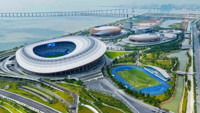
08.2025 © CSCEC 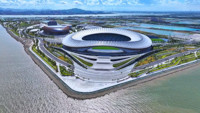
09.09.2025 © 永恒飞翔 (www.douyin.com) 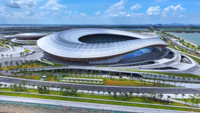
09.09.2025 © 永恒飞翔 (www.douyin.com) 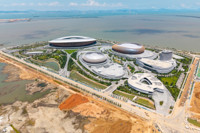
08.06.2025 © Tim Wu (CC BY-SA 4.0) 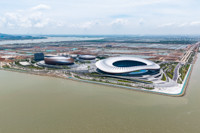
08.06.2025 © Tim Wu (CC BY-SA 4.0) 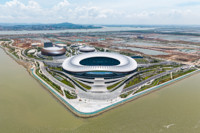
08.06.2025 © Tim Wu (CC BY-SA 4.0) 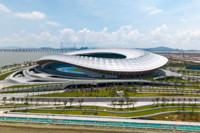
08.06.2025 © Tim Wu (CC BY-SA 4.0) 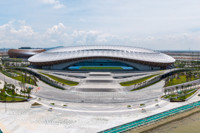
08.06.2025 © Tim Wu (CC BY-SA 4.0) 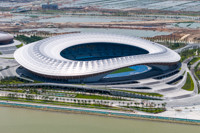
08.06.2025 © Tim Wu (CC BY-SA 4.0) 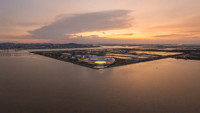
09.09.2025 © 陈国亨 (www.douyin.com) 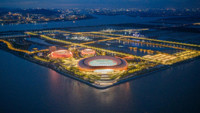
08.2025 © chinadaily.com.cn 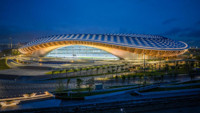
08.2025 © chinadaily.com.cn 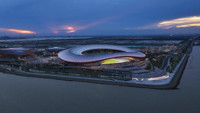
23.08.2025 © 二中兄 (www.douyin.com) 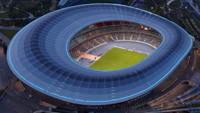
23.08.2025 © 二中兄 (www.douyin.com) 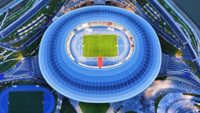
23.08.2025 © ainyone (www.douyin.com) 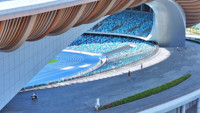
09.09.2025 © 永恒飞翔 (www.douyin.com) 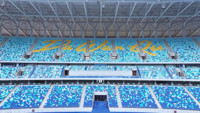
09.09.2025 © 永恒飞翔 (www.douyin.com) 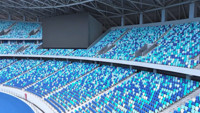
09.09.2025 © 永恒飞翔 (www.douyin.com) 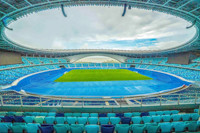
08.2025 © CSCEC 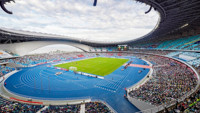
08.2025 © CSCEC 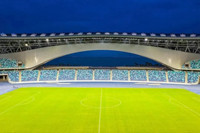
08.2025 © CSCEC

 StadiumDB
StadiumDB